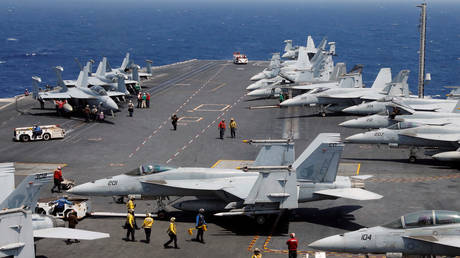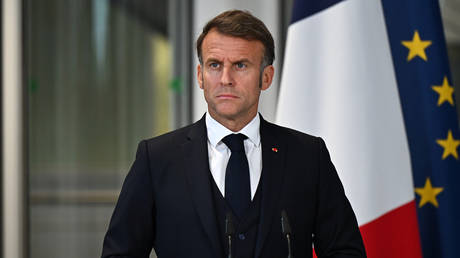
Global defense spending saw its largest annual increase in a decade in 2019, proving that the trend for bloated military budgets is here to stay – but expenditure doesn’t always correlate simply with power, analysts told RT.
With military budgets peaking at a colossal $1.9 trillion last year (a 3.6 percent increase on 2018), it is clear that governments are still deeply in love with throwing massive amounts of money into the production and acquisition of the latest and fanciest new weapons of war. We have now reached the “highest level of spending since the 2008 global financial crisis,” according to the Stockholm International Peace Research Institute’s (SIPRI) latest annual report.
So, who are the biggest players, and more importantly, do their budgets really reflect their military capabilities and power?
The top five and the ‘Asian century’?
The clearest trend from the latest SIPRI data is that the US is still leading the pack in terms of numbers, boosting its spending to record levels. Meanwhile, Asian powers like China and India spend far less, but are steadily building on earlier increases. After cuts in 2017 and 2018, US bugbear Russia also increased its spending by 4.5 percent in 2019, while fifth-biggest spender Saudi Arabia’s budget fell by 16 percent.
Spending by the top five military giants accounted for 62 percent of the total global expenditure of $1.9 trillion last year. Put another way, that equates to approximately $249 for every person on Earth.
Last year’s spending was also significant in another way, as it marked the first time that two Asian states (China and India) have featured in the top three spenders.
While the coming decades will certainly see China and India emerge as even more significant military powers, that “does not automatically nullify or decrease the role of other non-Asian military powers” like the US, which will remain the foremost military superpower “for the observable future,” Dmitry Suslov, deputy director at the Center for Comprehensive European and International Studies at HSE, told RT.
Likewise, the rise of Asia won’t diminish the power of Russia, which has “significantly improved its conventional military capabilities and modernized its nuclear capabilities,” Suslov added. Ultimately, we will probably see “a military multipolarity in the world with India and China being full-fledged members and full-fledged poles of the multipolar system.”
‘Wasteful’ United States
The US spent a gargantuan sum of $732 billion on its military in 2019, accounting for 38 percent of the global spend. Putting that in context, the budgets of the next four countries (China, India, Russia and Saudi Arabia) combined were still almost $300 billion less than Washington’s expenditure. Always eager to prove it has the deepest pockets when it comes to the military, the US has remained the top spender for several decades – but has it paid off?
The US is an example of a country which has spent a massive amount while experiencing a relative decline in power and capabilities, Suslov said.
“You can spend less money but do it wisely and effectively and you can spend a lot of money but less effectively and more irrationally – and in this case, your military capacity will be decreased,” he said. Effectiveness is key, “not just the sheer size” of the budget. For instance, Washington “wastes money on false priorities” like state-building in places like Iraq and Afghanistan, he added.
Steadily growing China
China allocated about $261 billion to its military last year. The Asian giant’s military expenditure has increased continuously since 1994. Taking a snapshot of the past decade, Beijing’s spend was 85 percent higher in 2019 than it was in 2010 – showing that the country’s growth in military spending has closely matched its recent economic growth.
Regional tensions in Asia and rivalry with Washington are clearly key drivers of Beijing’s growth in spending. With the Covid-19 crisis exacerbating US-China tensions even more, some Republicans in Congress are seeking to create a dedicated fund specifically designed to counter China as a rising military force.
China’s increasing budget is also a driver of higher spending in the wider Asian region, as its growing power forces other neighboring states to ramp up their own capabilities. For example, “Chinese military expenditure automatically translates to a rise in India’s spending,” Suslov said.
Another indicator that the US’ massive budget hasn’t translated into absolute superiority is the fact that China has managed to “asymmetrically challenge” Washington in the South China Sea and around Taiwan in recent years despite not boasting the same level of overall military might, Dinkar Peri, defense analyst and The Hindu journalist told RT.
Incoming India
India, which is now the world’s fifth-largest economy, had the third-largest defense budget in 2019 at $71.1 billion – representing a significant 6.8 percent increase over last year, overtaking both Russia and Saudi Arabia.
The country’s defense expenditure has grown 259 percent over the past 30 years (by 37 percent since 2010) – and the increase is “absolutely logical,” according to Suslov, since it is also a major growing economy.
“All great powers who pursue independent policies, who do not outsource their security and defense to the others, who refuse to accept the hegemony of the others obviously translate their economic success and rise into military power,” he said.
In addition, India finds itself in a “very uneasy regional and global environment” facing its traditional rivalry and struggle with Pakistan and now strategic competition with China, which makes it feel the “necessity to catch up,” Suslov added.
India’s armed forces have been undergoing modernization under Prime Minister Narendra Modi – and as the world’s second-largest arms importer, New Delhi purchases equipment from both Russian and Western manufacturers, balancing both East and West in a way that it hopes will give it a military edge in the region.
One of India’s main ambitions now is to build its own domestic defense capabilities. Though it still has limited abilities in this regard, it has made strides in recent years, setting a target goal of $5 billion in exports over five years
It’s also important to look at allocations within India’s spending, Peri said. The country has “a ballooning segment of military pensions.” In fact, pensions and salaries account for more than half of the country’s defence spending – the highest among the top spenders – leaving a much smaller budget for procurement of arms.
Transforming Russia?
Moscow was the fourth-biggest spender in 2019 with expenditure of $65.1 billion. Its military expenditure has grown significantly across the past 20 years, increasing in real terms by 30 percent between 2010 and 2019. Yet, while it is regularly framed by the US and its NATO allies as ‘the world’s greatest aggressor,’ Russia is the only country in the top five spenders whose budget has declined at all in recent years (seeing decreases in both 2017 and 2018). Overall, US spending was 11 times greater than Russia’s, while China’s was four times greater.
Russia is an example of a country which spends less money but allocates it more effectively and in a “much more targeted way,” Suslov said. Despite its relatively small military budget, Moscow has, for example, become a “global leader” in hypersonic and strategic nuclear weapons. Russia is also still “far more advanced and far ahead of China in terms of both nuclear force and conventional power projection capacity,” Suslov explained.
The gap between Moscow and Beijing will disappear in the next couple of decades and China will surpass Russia in terms of military capacity “but it will take time,” Suslov said.
Slipping Saudi Arabia
In fifth spot is Saudi Arabia with a $61.9 billion spend in 2019, falling 16 percent from third place the year before. The drop in 2019 was “unexpected” according to SIPRI, after Riyadh continued its military operations in Yemen and following increasing tensions with Iran after attacks on its oil fields in September which it blamed on Tehran. It seems falling oil prices may have forced Saudi Arabia to cut military spending.
While defense spending and conventional military might is usually seen as the best indicator of power, there are other factors to consider, too. “Investment and capabilities in hard infrastructure, and critical sectors like cyber, space and artificial intelligence” should be looked at in combination with military spending, Peri said.
Indeed, “defense spending” itself may be a misnomer, Phyllis Bennis, program director of the New Internationalism Project at IPS, believes. The term is used to make “military spending” sound more acceptable, when in fact protection of people is an entirely different thing. “Those are issues of healthcare, as we now know [with]this pandemic. It means taking care of the environment, it means jobs, education; those are the things that protect and defend people,” she said.
With total global spend of $1.9 trillion, it seems military expenditure in the pre-Covid-19 world had peaked – but following the pandemic and the resultant humanitarian and economic crisis that is expected to unfold, it looks more than likely that defense spending will decline in most places.
It seems certain, however, that given regional tensions and growing global competition between military superpowers like the US and China, the world’s top five big spenders are unlikely to change much over the coming decade.
Think your friends would be interested? Share this story!




